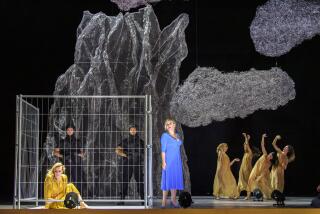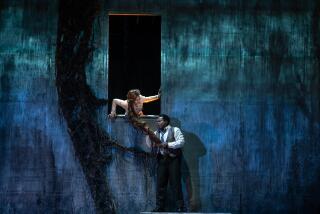Review: A passionate Sellars-Rattle triumph with Bach’s ‘St. Matthew’
- Share via
Reporting from London — Bach’s “St. Matthew” Passion, that most exalted of music’s numinous monuments, was performed Saturday night by the exalted Berlin Philharmonic, conducted by the exalted Simon Rattle, sung by superb (and of course exalted) soloists and chorus at the Proms in that London monument, the spacious Royal Albert Hall.
The performance was further, and significantly, “ritualized” by Peter Sellars.
A spiritual journey was made personal and communal, an offering not only to each listener as an individual but meant also as a collective experience. More than 5,000 sat or stood in seeming quiet wonder through a long Passion.
There were no projected titles translating the German text. Although the text was printed in the program, it was hard to take one’s eyes off the stage. Jesus’ death is here a necessary encounter with persecution and death as we know it today.
We were, in mass meditation, all one, I thought. This 66th of the 72 Proms concerts was the most anticipated event of the world’s largest classical music festival. The triumph felt historic, especially given Sellars’ shaky history in Britain.
He made a controversial debut at Glyndebourne Touring Opera in 1987 with his unconventional production of Nigel Osborne’s “The Electrification of the Soviet Union.” Three years later, Sellars’ startling Glyndebourne Festival production of Mozart’s “Magic Flute,” set among drug addicts on Sunset Boulevard in West Hollywood, was called “the flattest, laziest, emptiest piece of work in festival history” by the Financial Times,
Sellars has since succeeded in Britain, and a brilliant production of Mozart’s “Idomeneo,” conducted by Rattle and featuring Czech mezzo-soprano Magdalena Kozená, led to the marriage of Rattle and Kozená, the alto soloist in the “Matthew” Passion.
But no, we were not one flock Saturday. There were deniers. Deeming Sellars’ direction to be ludicrous “tree-hugging, encounter-group style,” the Telegraph opera critic Rupert Christiansen feared that during the aria “Buss und Reu,” in which Mary Magdalena pours ointment on Jesus’ body, “we were about to witness an act of fellatio” by Kozená. The blog site Slipped Disc has posted the cowardly anonymous remarks by “a leading member of London musical community” who walked out, saying that Rattle “had no idea about the music or its purpose.”
In fact, this was a challenging, confrontational and shockingly sensual “Matthew” Passion, not for the fearful.
Sellars’ purpose, he has said, was to remove the voice of authority, be it church, state or musical establishment. He worked for a month with the chorus, going through the text word by word.
He then tricked the orchestra players, as Rattle recently put it, “to leave their egos in their music cases.” Bach accompanies arias with solo instruments, and Sellars persuaded the first chair players to memorize their solos and interact theatrically on stage with the singers.
The heart of this Passion performance, though, is the role of the Evangelist, Matthew, sung, enacted, internalized and transformed by the remarkable British tenor Mark Padmore, in a performance of a lifetime.
Sellars begins with the chorus, which Bach divides into two (as the composer does the orchestra), running onstage in chaos, uncomprehending the news of the Crucifixion. The Passion performance, then, becomes the piecing together of what had happened, along with the posing of, without easily answering, moral questions.
Mary Magdalene has the most arias, and given her name, Magdalena Kozená has perhaps more reasons than merely musical to take them personally. Her performance is one of animal magnetism, of raw emotion unfettered. The dynamism is daring, especially in her more flirtatious moments with orchestra and chorus members, she being their music director’s wife.
This magnificent unsettling becomes contagious to the other soloists — soprano Camilla Tilling, tenor Topi Lehtipuu and bass-baritone Eric Owens, who appears as a kind of imposing angel. Christian Gerhaher’s poised Christ undergoes a profound disappearing act, singing first onstage but removed out of sight to distant balconies as the evening progresses. No longer a presence but a memory, he becomes an ideal difficult to absorb or understand.
Rattle’s approach is radical. Onstage, conducting in the midst of it all, he becomes part of the action. As a Bach interpreter, he is an exuberant searcher, as he attempts to bridge full-blossomed Berliner orchestral beauty with his experience in more tart early music period practice, all the while making room for avid theater. Sometimes he just stands and watches, absorbed in the action, some of it his wife’s indelicate carrying on.
The greatness Rattle ultimately brings to Bach is not purpose and meaning but uncertainty. This is a Bach changing with the times, ever fresh and never allowing any place to hide. Rattle finds different solutions than he did in 2010 (that performance is on DVD), and will no doubt come at it again with a yet different maturity five years from now.
Meanwhile, this “Matthew” Passion will travel next month to New York as the highlight of Lincoln Center’s White Light Festival. The production will not, however, continue west.
What more meaningful way might there have been for the Music Center to celebrate its 50th anniversary this fall? Sellars is an Angeleno; Rattle has had a long history with Los Angeles Philharmonic; the staging was inspired by the layout of the Berlin Philharmonie, which inspired the layout of the Walt Disney Concert Hall stage.
Unfortunately, our Music Center lacks the passion of the Lincoln Center.
More to Read
The biggest entertainment stories
Get our big stories about Hollywood, film, television, music, arts, culture and more right in your inbox as soon as they publish.
You may occasionally receive promotional content from the Los Angeles Times.











